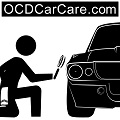The Fundamental Variables of Paint Polishing:

By Christopher Brown of OCDCarCare Los Angeles – OCDCarCare.com
Machine Speed: the setting on a paint polishing machine dial determining the speed the backing plate rotates, ultimately moving the pad face.
The ”Best’ machine speed cannot be determined since competing manufacturer’s machines will differ from setting to setting. Additionally, machine speed and real world polishing efficiency are greatly influenced by a host of other factors such as: defect level, contours of the surface, correction liquids, etc.
Machine Speed Under Load
Though a motor may be listed as “X” speed, the actual the speed of the machine, when engaged in paint correction, may differ. Some machines may have a ‘low’ power rating on their motor, yet work better when pressed against a surface. This actually increases their working power and ‘speed settings.’
Familiarity with each machine is the ultimate guide to understanding which speed settings are optimal under individual conditions. Keep in mind; paint type and defect levels will partially influence the optimal working speed of the machine.
Other factors also influence machine speed such as: climate, pad type, and correction liquid. Therefore, machine speed adjustments might need to happen from moment to moment. A DA polisher working on vertical panels is an example. Machine speed is increased to obtain optimal backing plate due to the curvature of the panel, gravity, and the ever changing directional force placed on the machine.
Primary Purpose of Machine Speed for Paint Correction
With a Dual Action Polisher, backing plate rotation overrides the speed setting on the machine dial.
The lateral oscillation (side to side) movement, also called the throw or stroke, coupled with backing plate rotation grants the DA Polisher its full correction power. Therefore, the backing plate rotation rate is the main variable which spins the pad, or disc, against the paint.
As a general rule, pad rotation of 1-2 rotations per second provides optimal cutting capabilities. More rotations of the pad will not ‘optimize’ cycle time of a particular correction liquid. Therefore, with DA Polishers, one fact ranks highest among all others for altering machine speed– BACKING PLATE ROTATION.
Generally optimal backing plate rotation is 1-2 revolutions per second.
It’s best to run the machine at the lowest possible setting to achieve this rate of backing plate rotation.
Operating the machine at a minimal setting allows the machine to run smoother, placing less stress on the machine and less physical strain on the operator. These parameters also help to greatly increase tool longevity since the motor doesn’t have to work as hard.
© Christopher Brown – OCDCarCare Los Angeles – OCDCarCare.com – 2013
Click here if you missed Pt. 1, 2, or 3 of the series: The Fundamental Variables of Paint Polishing
For more interesting topics on: auto detailing, paint polishing, and car care please browse: OCDCarCare Los Angeles’s – Detailing Article Archive.
- Vehicle Water Spots Explained: Formation, Removal, & Prevention - 28 August, 2023
- Automotive Paint Thickness Gauge (PTG): Detailing User Guide - 2 September, 2022
- 5 Thin Automotive Paint Layers Explained For Detailing - 10 July, 2022
